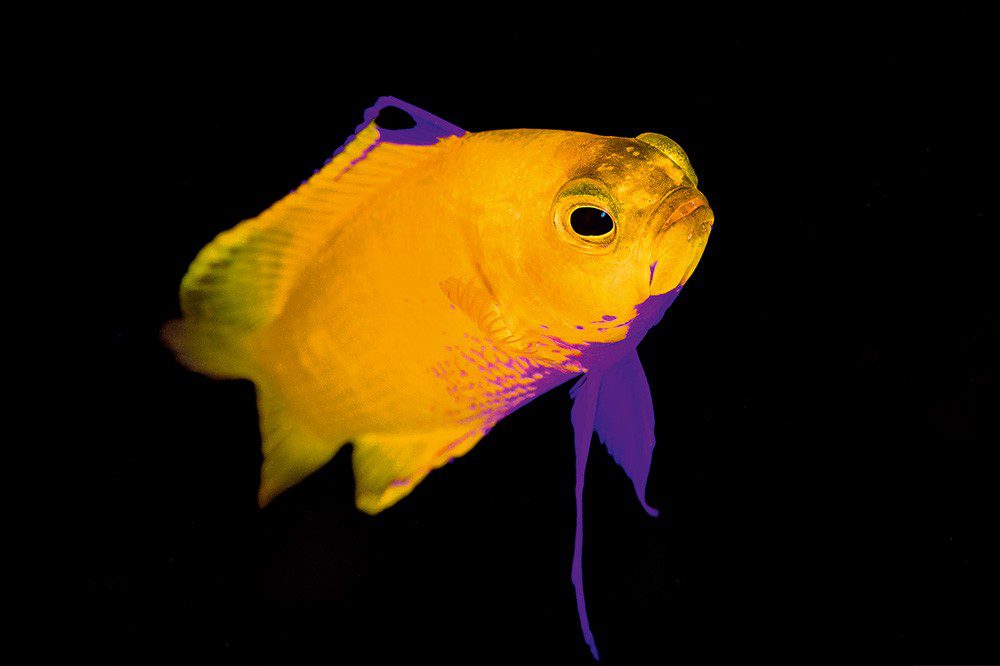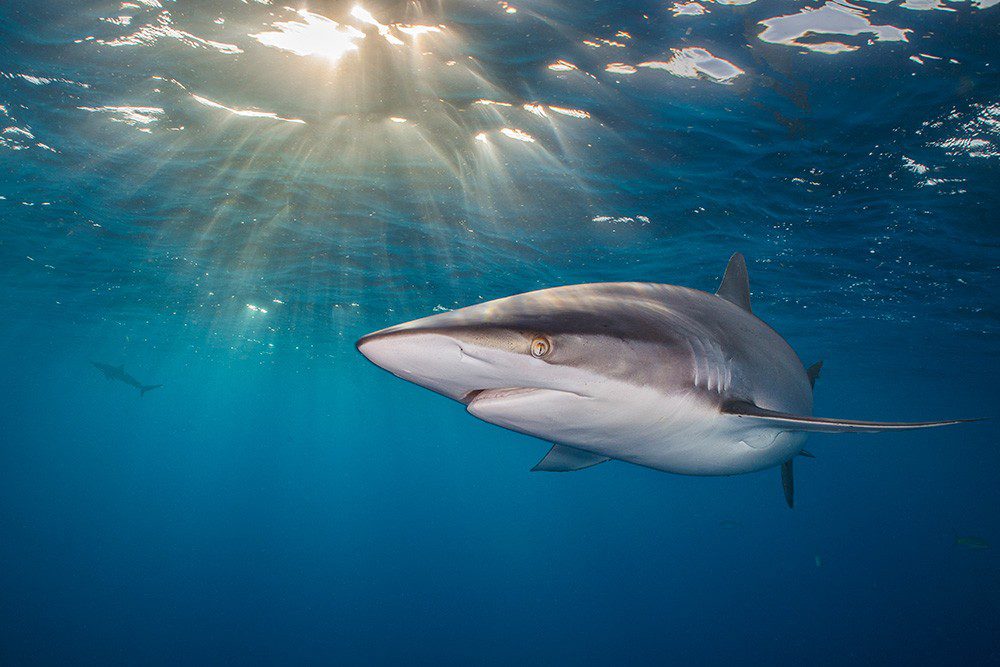Deprecated: Automatic conversion of false to array is deprecated in /home/837581.cloudwaysapps.com/gcahrcedfn/public_html/wp-content/plugins/link-whisper-premium/core/Wpil/Settings.php on line 3073
PHOTO TECHNIQUE
Be The Champ!
In the last of his mini-series in photography in iconic dive destinations around the world, ALEX MUSTARD moves on to Cuba. If you thought the Jardines de la Reina was all about winning shark shots, it’s time for a rethink
‘It’s like diving back in time – a chance to see
Caribbean reefs as they should be’

Grouper are all about faces and character.
Taken with a Nikon D5 & Nikon 28-70mm with Nauticam WACP. Subal housing. 2 x Seacam strobes. 1/100th @ f/13, ISO 640.
Cuba, great! I still don’t understand why it isn’t more popular,” replied divEr’s Editor, Steve Weinman, when I told him of my plans for this month’s theme.
Cuba, and specifically the Jardines de la Reina, or Gardens of the Queen, is
a fitting finale for this mini-series of photo tips for once-in-a-lifetime dive destinations.
The Jardines de la Reina is far from the only place to dive in Cuba, but it is certainly the stand-out locale for photography. This is a 90-mile-long archipelago of reef and cays, renowned for pristine corals and fishy Caribbean reefs, stuffed with big animals.
To be honest, this is how all reefs should be, but these days we tend to find this only where we have the classic one-two of remote location and protection, just like Misool. Sadly it seems that conservation works best when it is geographically inconvenient for people to break the marine-park rules…
The Jardines are 60 miles offshore from the small port of Jucaro, itself a six-hour coach trip from Havana. And they have been officially protected as a national park for decades, with fishing tightly controlled and visitor numbers limited. The upshot is that marine life flourishes with a richness that is irresistible to photographers.
Appeared in DIVER August 2019
Healthy, thriving corals are a key characteristic of these reefs, packed in with a density that you rarely see in the Caribbean. The reason is that Caribbean reefs changed forever in the early 1980s, when almost all of the dominant reef-building branching corals were wiped out by disease (that scientists later discovered originated from human sewage).
Coral cover on Caribbean reefs before 1980 was around 50%, and since then has been stuck at 20%. In short, corals died and seaweeds took over. Seaweeds got their chance because the vegetarian fish that should have been there to mow them down were already fished out.
And the dominance of seaweeds has stopped the corals from recovering.
The Jardines are one of the few places that buck this trend. The shallows have dense forests of branching elkhorn coral, packed with grunts.
There are giant pillar corals, which extrude their polyps during the day, giving them a furry appearance.
And everywhere the seabed is packed with life. It’s like diving back in time, a chance to see Caribbean reefs as they should be. This, personally, was my biggest motivation for visiting Cuba.
As underwater photographers the corals are something we should shoot – it’s an important story to tell – so that people are aware of what they should be seeing when diving elsewhere in the region. But to be honest, when you go somewhere as special as this, you won’t want to spend too long on the corals!
STARTER TIP
Hard corals are challenging subjects to make interesting. I usually use crossed strobe-lighting on them, pulling my strobes out wide and angling them in at the coral to light the scene evenly, but also to emphasise the texture and shape of the colonies.
Always try to get some fish into the frame to give the picture life.
An early lesson for any ecology student is that there are always fewer predators than prey. There are more rabbits than foxes, more zebras than lions.
Unusually, coral reefs can buck this trend and can be home to a greater weight of large predators than small fish.
This is possible because the small fish replenish their numbers quickly, so the mass of them at any moment is much less than the mass added up over a year, and also because the bigger predators, being cold-blooded, need to eat far less than a similar-sized mammal or bird.
Sadly, we don’t see this pattern on most reefs because of fishing, which culls the large, long-lived predators and leaves small fish to dominate.
But Cuba, like Palau, is one of the places where the big fish are still present in impressive numbers.
In the Jardines, each dive-site has multiple large, friendly groupers, including characterful Nassau, mean-looking black groupers and ginormous Goliath groupers.
For me, grouper are all about faces, the personality that comes through from their large eyes and botoxed lips. And the friendlier the fish, the better we will be able to capture this character.
Thankfully the Jardines has plentiful inquisitive groupers, but to get the best encounters we still need to be as quiet as possible in the water.
The best technique is close-focus wide angle, and we should set up our strobes tight to the housing before we move in, to avoid unnecessary flapping around that will spook even friendly souls.
Then we just have to wait for that moment of peak eye contact or, if we’re really lucky, a yawn.
The forgotten stars of Cuba’s reefs are the macro subjects. Although many photographers think of this place as a wide-angle destination, these rich reefs are great for macro too.
Furthermore, since most macro photography is done in South-east Asia, Caribbean reefs offer plenty of rarely photographed subjects. My favourites are some of the common reef fish, especially the spectacularly coloured purple and yellow fairy basslet and its rare cousin, the almost entirely yellow golden basslet.
These Jardines reefs are also a great location for two of the most photogenic Caribbean blennies – the hydrodynamic arrow and the cheeky spinyhead. The latter in Cuba often lives in old barnacle shells covered in richly coloured sponges, creating a stunning shot.
MID-WATER TIP
Friendly grouper are fabulous subjects for close-focus wide angle, but don’t make the mistake of focusing only on your foreground. As with all wide-angle shots, you still need a background to create a pleasing image.
Frame the subject against some attractive reef, or wait for other grouper, sharks or divers to swim into frame to give you a secondary subject.
Sharks also thrive on these reefs and are permanently popular photographic subjects. On the shallow reefs, butch Caribbean reef sharks dominate, while silky sharks, big and small, can be encountered at the surface above the deeper sites.
I’ve shot Caribbean reef sharks in many places, not least the Bahamas, so in Cuba I’d recommend focusing less on portraits of this species and instead using them within beautiful reef scenic shots.
I start by watching for their typical route, and then plan a shot around a pretty section of the reef in their path.
First, I’ll perfect my composition and set up my lighting, then I’ll try and hide as much out of sight as I can and wait for a close pass, springing up at the last moment to grab the shot.
Silkies are pelagic, and backgrounds are harder to come by. The main options are the boat, other divers, other sharks, surface or attractive sun rays, although this last one is possible only when the sun is out and it isn’t windy. The silkies are inquisitive, and if you’re patient you’ll get those winning images.
ADVANCED TIP
I’ve seen many photographers produce splits-shots of the silkies here, particularly at sunset, although I have not had the chance myself. The trick to these shots is to fix your focus under water and use a small aperture to maximise depth of field to get everything in focus.
Next, expose for the sky with your shutter speed and adjust your flash power for the sharks.



